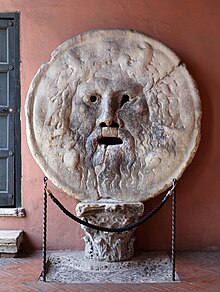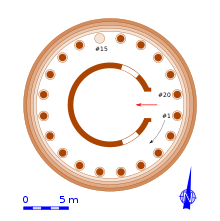 The Temple of Hercules Victor, in the Forum Boarium | |
 Click on the map for a fullscreen view | |
| Coordinates | 41°53′19″N 12°28′51″E / 41.8887°N 12.4808°E |
|---|---|
The Temple of Hercules Victor (Italian: Tempio di Ercole Vincitore) or Hercules Olivarius (Latin for "Hercules the Olive-Bearer")[1] is a Roman temple in Piazza Bocca della Verità, the former Forum Boarium, in Rome, Italy. It is a tholos, a round temple of Greek 'peripteral' design completely surrounded by a colonnade. This layout caused it to be mistaken for a temple of Vesta until it was correctly identified by Napoleon's Prefect of Rome, Camille de Tournon.[2]
Despite (or perhaps due to) the Forum Boarium's role as the cattle market for ancient Rome, the Temple of Hercules is the subject of a folk belief claiming that neither flies nor dogs will enter the holy place.[3] The temple is the earliest surviving mostly intact marble building in Rome and the only surviving one made of Greek marble.[4]
Description
[edit]
Dating from the later 2nd century BC and erected by L. Mummius Achaicus, conqueror of the Achaeans and destroyer of Corinth,[5] or by Marcus Octavius Herrenus,[6] the temple is 14.8 m in diameter and consists of a circular cella within a concentric ring of twenty Corinthian columns 10.66 m tall, resting on a tuff foundation. These elements supported an architrave and roof, which have disappeared.[7]
The original wall of the cella, built of travertine and marble blocks, and nineteen of the originally twenty columns remain but the current tile roof was added later. Palladio's published reconstruction suggested a dome, though this was apparently erroneous. The temple is the earliest surviving marble building in Rome. The temple's original dedication is dated back to circa 143-132 BC, a time when intense construction was taking place in Portus Tiberinus.[8]
Identification
[edit]
Its major literary sources are two almost identical passages, one in Servius' commentary on the Aeneid (viii.363)[9] and the other in Macrobius' Saturnalia.[10] Though Servius mentions that aedes duae sunt, "there are two sacred temples", the earliest Roman calendars mention but one festival, on 13 August, to Hercules Victor and Hercules Invictus interchangeably.[11]

Post-Classical history
[edit]
In the 1st century AD, the temple was hit with some sort of disaster as 10 columns were replaced with Luna marble, which is similar to the original but not an exact replica.[12] By 1132, the temple had been converted to a church, known as Santo Stefano alle Carozze (St. Stephen 'of the carriages'). In 1140, Innocent II converted the temple into a Christian church dedicating it to Santo Stefano.[13]
Additional restorations (and a fresco over the altar) were made in 1475. A plaque in the floor was dedicated by Sixtus IV. In the 12th century, the cella wall was replaced with brick faced concrete and windows were added as well.[14]
In the 17th century, the church was rededicated to Santa Maria del Sole ("St. Mary of the Sun"). The temple and the Temple of Vesta in Tivoli were an inspiration for Bramante's Tempietto and other High Renaissance churches of centralized plan.[citation needed] Between 1809 and 1810, the surrounding ground level was lowered and the temple was restored once again.[15] The temple was recognized officially as an ancient monument in 1935 and restored in 1996.[16]
See also
[edit]- Hercules in Roman religion
- Temple of Hercules Musarum and the Ara Maxima
- Temple of Portunus
- List of Ancient Roman temples
References
[edit]Citations
[edit]- ^ Barton Sholod, "Charlemagne in Spain. The Cultural Legacy of Roncesvalles", p. 144
- ^ "...houses built into the round Temple of 'Vesta', which de Tournon correctly identified as of Hercules Victor, were removed" in 1811 (Salmon 1995, 150).
- ^ Leone Battista Alberti, Architecture Archived 2011-06-05 at the Wayback Machine, trans. James Leoni (1755), p. 117.
- ^ "Temple of Hercules". World Monuments Fund. Retrieved 2019-12-15.
- ^ For its dating, see Ziolkowski 1988, 314ff; Ziolkowski's argument for its dedicator and criticisms of other scholars' candidates: 316ff.
- ^ Loar, Matthew P. (2017-01-01). "Hercules, Mummius, and the Roman Triumph in Aeneid 8". Classical Philology. 112 (1): 45–62. doi:10.1086/689726. ISSN 0009-837X. S2CID 164402027.
- ^ Loar, Matthew P. (2017-01-01). "Hercules, Mummius, and the Roman Triumph in Aeneid 8". Classical Philology. 112 (1): 45–62. doi:10.1086/689726. ISSN 0009-837X. S2CID 164402027.
- ^ Loar, Matthew P. (2017-01-01). "Hercules, Mummius, and the Roman Triumph in Aeneid 8". Classical Philology. 112 (1): 45–62. doi:10.1086/689726. ISSN 0009-837X. S2CID 164402027.
- ^ sed Romae victoris Herculis aedes duae sunt, unam ad Portam Geminam, alia ad Forum Boarium.
- ^ Noted by Ziolkowski 1988:309 and notes; the other temple was that of Hercules Invictus ad Circum Maximum.
- ^ Adam Ziolkowski 1988:311 and note 6 demonstrates the interchangeability that developed for the two originally separate epithets.
- ^ "Temple of Vesta/Hercules, Rome". World History Encyclopedia. Retrieved 2019-12-15.
- ^ "Temple of Hercules". World Monuments Fund. Retrieved 2019-12-15.
- ^ "Temple of Vesta/Hercules, Rome". World History Encyclopedia. Retrieved 2019-12-15.
- ^ Yang, Jing; Zhang, Wen Fang (August 2012). "The Seismic Performance Analysis of Brick Masonry Wall between Windows with Central Reinforced Concrete Constructional Columns". Applied Mechanics and Materials. 193–194: 1221–1225. Bibcode:2012AMM...193.1221Y. doi:10.4028/www.scientific.net/amm.193-194.1221. ISSN 1662-7482. S2CID 108832442.
- ^ See Alessandro Pergoli Campanelli, Restauro del cosiddetto Tempio di Vesta, in "AR", XXXV, 32, novembre-dicembre 2000, pp. 26-30.
Sources
[edit]- Alberti, Leone Battista. Architecture, 1755, tr. Leoni, James.
- Claridge, Amanda. Oxford Archaeological Guides - Rome. Oxford University Press, 1998
- Coarelli, Filippo. Guida Archeologica di Roma. Arnoldo Mondadori Editore, Milano, 1989.
- Salmon, Frank (1995). "'Storming the Campo Vaccino': British Architects and the Antique Buildings of Rome after Waterloo". Architectural History. 38: 146–175. doi:10.2307/1568626. JSTOR 1568626. S2CID 158291335.
- Woodward, Christopher. The Buildings of Europe - Rome. page 30, Manchester University Press, 1995. ISBN 0-7190-4032-9
- Ziolkowski, Adam (1988). "Mummius' Temple of Hercules Victor and the Round Temple on the Tiber". Phoenix. 42 (4): 309–333. doi:10.2307/1088657. JSTOR 1088657.
- Loar, Matthew Hercules, Mummius, and the Roman Triumph in Aeneid 8.” Classical Philology, www.journals.uchicago.edu/doi/10.1086/689726.
External links
[edit]- Detailed photographs of the interior and features of the building
- High-resolution 360° Panoramas and Images of Temple of Hercules | Art Atlas
- Lucentini, M. (31 December 2012). The Rome Guide: Step by Step through History's Greatest City. Interlink. ISBN 9781623710088.
![]() Media related to Temple of Hercules (Rome) at Wikimedia Commons
Media related to Temple of Hercules (Rome) at Wikimedia Commons
| Preceded by Temple of Hadrian |
Landmarks of Rome Temple of Hercules Victor |
Succeeded by Temple of Janus |

